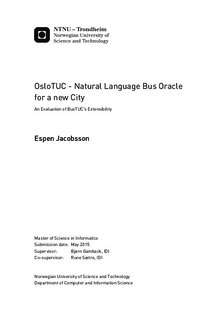OsloTUC - Natural Language Bus Oracle for a new City - An Evaluation of BusTUC's Extensibility
Master thesis
Permanent lenke
http://hdl.handle.net/11250/2353532Utgivelsesdato
2015Metadata
Vis full innførselSamlinger
Sammendrag
The recent years have seen an increased demand for smart phones and other handheld devices. This gives producers of applications or content an excellent opportunity to reach out to a larger audience than before, and it gives them a chance to make their applications a part of people's everyday lives.
In this thesis, a well-established natural language travel planner for buses was modified. This was done in order to understand what is required when providing support for a new city. In 2013, Marius Qvam Wollamo added support for trams in Trondheim, and provided the travel planner with a map (Wollamo, 2013). His idea of using a map was an inspiration for this thesis, and the recent increase in the use of mobile devices was an encouragement to create a multi-platform application utilizing map features. A prototype of such an application was developed to try to meet the needs of users, whether they are in front of a desktop computer or on the move with their mobile devices. A survey was conducted with the aim to find out how users of such an application ideally want to query a travel planner, and how they want the returned information to be displayed. A questionnaire was created and distributed to a number of respondents who were asked to compare the new prototype with an existing travel planner. The survey showed that the prototype was well received, and that the displayed information gave varying, but overall positive results. The results of the questionnaire gave grounds for discussing the implemented features, and whether the application was accessible to users with disabilities. A tendency to favor natural language over filling in predefined boxes, as well as a preference to see sufficient metadata about the routes being suggested, was observed. Providing the ability to search for bus stop names in real time was found to be preferable with the users. The work done has shown that it is possible to fully transfer the functionality of the travel planner in one city to another, and that a mobile friendly interface is to be preferred.
